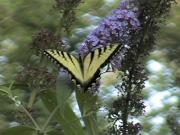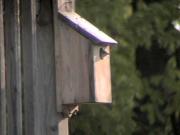10. Feeders Keep Birds From
Migrating. If this were true, we'd
have hummingbirds and orioles clinging to our feeders all winter long. Birds
migrate when their natural internal "clocks" give them the urge to migrate.
Migration is driven by instinct and external factors such as sunlight and
weather, not by the availability of sunflower seed or food at feeders. One thing
to note is that birds need extra food during migration, so it's a nice idea to
keep your feeders stocked in case a hungry migrant plops down in your yard
looking for food.
9. Bird Feeding
Is Really Bad/Good for Birds. Let's face
it, birds did just fine before we decided, a few hundred years ago, to feed
them. Birds do not need the food we provide for them. It's a nice compromise
between our desire to see birds in our backyards and the birds' willingness to
take advantage of our largesse. Birds do not rely solely on our feeders for
their survival, and they certainly do not rely on our feeders for necessary
nutrients, so it's wrong to say that feeding is "good" for birds. By the same
token, when bird feeding is done in a conscientious manner, it is also not bad
for birds. Yes, messy feeding stations can harbor disease, and food can
sometimes spoil at our feeders, but if these scenarios are avoided, bird feeding
is enjoyable for us and attractive to the birds. If you wish to stretch the
argument to include whether millions of bird feeders have an impact on bird
populations, then yes, we can argue about the negative effects of bird feeding.
But let's not do that now. Let's go on to the next myth.…
8. Birds Will
Starve if You Stop Feeding in Winter. Birds have evolved over the eons as incredibly adaptive, mobile
creatures. Unless a bird is sick or debilitated, it can use its wings (or legs)
to range far and wide in search of food. Birds that cannot move in search of
food are likely doomed to perish anyway, which is part of the natural scheme of
things. So when you're going away on vacation for two weeks in the middle of a
cold, snowy winter spell, it's nice if you can arrange for a neighbor to keep
your feeders filled. Most serious feeder operators wouldn't think of letting
their feeders go empty. But if it happens while you're gone, as it has happened
to me, realize that your birds did not all starve, they just went somewhere else
to find food. Now you'll have to work to lure them back!
7. The Mixed
Seed at the Grocery Store Is Bad. I
believed this with all my heart until recently when I saw some decent mixed
birdseed for sale at a fancy grocery store. Granted, the stuff at my local chain
grocery store is still absolute junk, unfit for rock doves. But some seed
producers seem to be getting the message that quality seed is worth selling. The
trick to telling the junk seed from the better stuff is to read the ingredients.
Junk seed has almost none of the following: black-oil sunflower, peanut bits,
safflower, millet, or sunflower hearts. It will have lots of milo, wheat,
barley, cracked corn, and upon visual inspection, perhaps some empty hulls,
sticks, and other inedibles. The best mixes feature a hearty helping of
sunflower seed in some form.
6. Birds Won't
Eat Milo. Years ago in an early issue of
Bird Watcher's Digest, one of our editorial cartoons stated emphatically that
"Real Birds Don't Eat Milo." Readers in the eastern half of North America nodded
in agreement, but those folks in the Southwest howled their ridicule and
protested loudly. Red milo is a staple of western bird feeding, especially in
the Southwest where a variety of quail, doves, towhees, and sparrows readily eat
it. In the East and upper Midwest, birds don't seem to eat milo much at all, so
any mixed seed with a large percentage of milo will probably go mostly
uneaten.
5.
Blackbirds/Squirrels Won't Eat Safflower Seed. Safflower was once considered by many feeder operators to be the
anti-blackbird and anti-squirrel food. Cardinals seemed to love it, but
blackbirds and squirrels did not. That's not really true anymore, but nobody
knows why. Many folks who feed safflower report that any bird or mammal that
eats sunflower will also eat safflower. Safflower seed is still a nice
alternative food to offer-it works in any feeder suitable for sunflower seed and
it can be bought in bulk at feed stores. A blackbird and squirrel deterrent it
is not, but then again, what is?
4. There's Only
One Hummingbird Species Found East of the Rocky Mountains.
Gone are the days when this statement could be
considered true. There are even breeding records for other hummingbird species
(mainly the buff-bellied hummingbird) in southern Texas. In winter this
statement is even less accurate because there can be as many as 10 different
hummingbird species visiting feeders throughout the southeastern states. In
addition to our regular eastern breeder, the ruby-throated hummingbird, eastern
states now regularly play host to rufous hummingbirds, a hardy species that can
breed as far north as Alaska. It is unclear if this is a new phenomenon or if
the explosive growth of hummingbird feeding has made these birds more
noticeable. I'm still waiting for the first good unusual hummer at our
feeders.
3. Red Dye in
Hummer Food Is Bad. We'd like to think we
know what is best for the birds we feed, but in a lot of cases, we don't. It
certainly seems logical that adding food coloring to humming-bird nectar
solution might not be good for the birds drinking it, but the fact is, we don't
have any scientific proof to that effect. So it's one of those
innocent-until-proven guilty things. And until some scientist does the testing,
there will continue to be millions of packages of red-dyed hummingbird nectar
being sold and used. As Jerry Seinfeld used to say: "Not that there's anything
wrong with that." This is what I'm saying: Hello out there. Any ornithology
graduate students reading this? I've got an idea for your
dissertation!
2. Perches on
Hummer Feeders Are Bad. It started out as
anecdotal evidence that grew into a wave of mild hysteria. Hummingbird feeders
with perches were killing hummingbirds! How? Well, the hypothesis was that
hummers would land on a feeder perch in the early morning and drink a deep slurp
of very cold nectar, and this jolt of coldness would cause them to go into
torpor, a trancelike state in which body functions slow drastically to conserve
energy. Some hummers were found hanging upside down from their perches, while
others fell to the ground and were at the mercy of predators. Witnesses reasoned
that the hummers did not generate enough body heat while sitting and thus
succumbed to the cold.
Removing the perches would force the hummers
to hover while feeding, thus generating body heat. Now, before you go out and
rip the perches off your feeders, consider that there are lots of reasons why a
hummer might behave in this way. The bird could be in a natural state of torpor,
which is how hummers survive in extremely cold weather. A hummer that has been
stung by a bee or wasp will behave strangely, as will one that is sick or
perhaps injured from the fighting that occurs near a busy feeder. In my
experience a feeder with perches allows many hummers to feed at once peacefully.
Hummingbirds forced to hover at feeders seem to fight more readily, and are more
active in defending a feeder. As with red dye, we don't have scientific evidence
to prove that feeders with perches are bad for hummingbirds, so until we do, use
your own good judgment. As for me, I'm pro perch.
1. This Feeder
Is 100% Squirrel Proof! I am sorry, but
there's just no way! Here I am setting myself up for angry letters from feeder
manufacturers, but it is simply impossible to believe this statement. Oh, yes,
you can make a feeder squirrel proof by placing it in the middle of a treeless
lawn with a pole-baffle that would do the Pentagon proud. But nail that same
feeder to your deck railing and watch the squirrels remove the confident smile
from your face, along with all the seed in your feeder. Squirrels have the
luxury of being way more resourceful than any bird feeder designer. Why? Because
a squirrel is working to feed itself and its offspring, and it will throw itself
into the task with all its might every single day. The squirrel thinks of
nothing else but the seed inside that feeder, and how to get at it. The feeder
designer, meanwhile, is thinking about lunch and vacation and next Tuesday's
staff meeting and bowling league. That's why the squirrels win every
time.
|






 Woodside Gardens
The Registry of Nature Habitats
Woodside Gardens
The Registry of Nature Habitats 
 1999 -
1999 -

![[Mourning Dove]](http://www.abirdshome.com/images/mdove1.jpg)
![[Rose Breasted Grosbeak]](http://www.abirdshome.com/images/grosbeak1.jpg)
![[White Breasted Nuthatch]](http://www.abirdshome.com/images/nuthatch1.jpg)
![[Cowbird]](http://www.abirdshome.com/images/cowbird.jpg)
![[Heron]](http://www.abirdshome.com/images/heron.jpg)
![[Water Attracts Wildlife]](http://www.abirdshome.com/images/yard1.jpg)

![[Downy Woodpecker]](http://www.abirdshome.com/images/dwoodpecker1.jpg)
![[Black Capped Chickadee]](http://www.abirdshome.com/images/chickadee1.jpg)
![[Wood Duck]](http://www.abirdshome.com/images/woodduck.jpg)
![[Ponds Attract Wildlife]](http://www.abirdshome.com/images/pond1.jpg)
![[Moths]](http://www.abirdshome.com/images/moth1.jpg)
